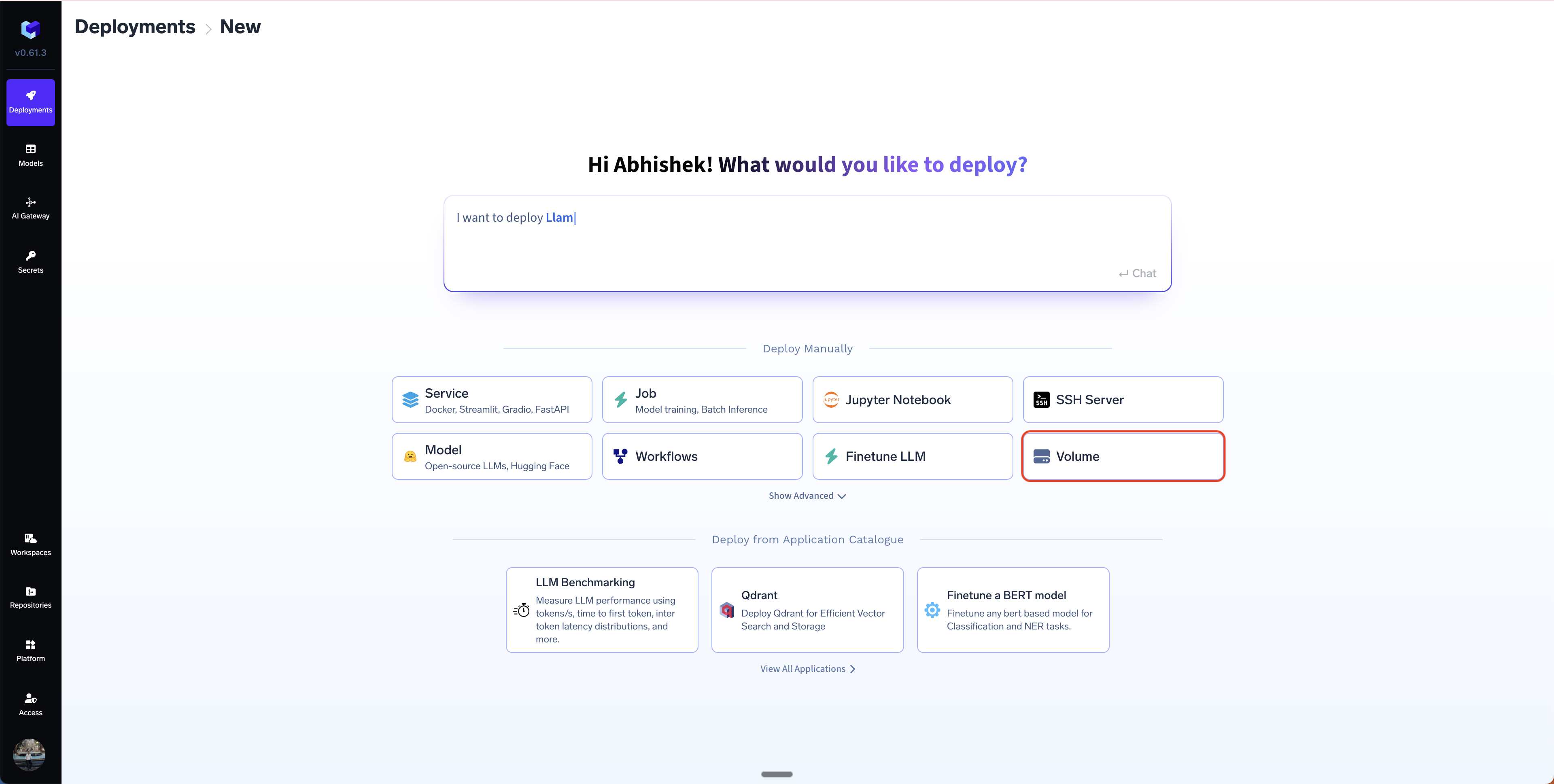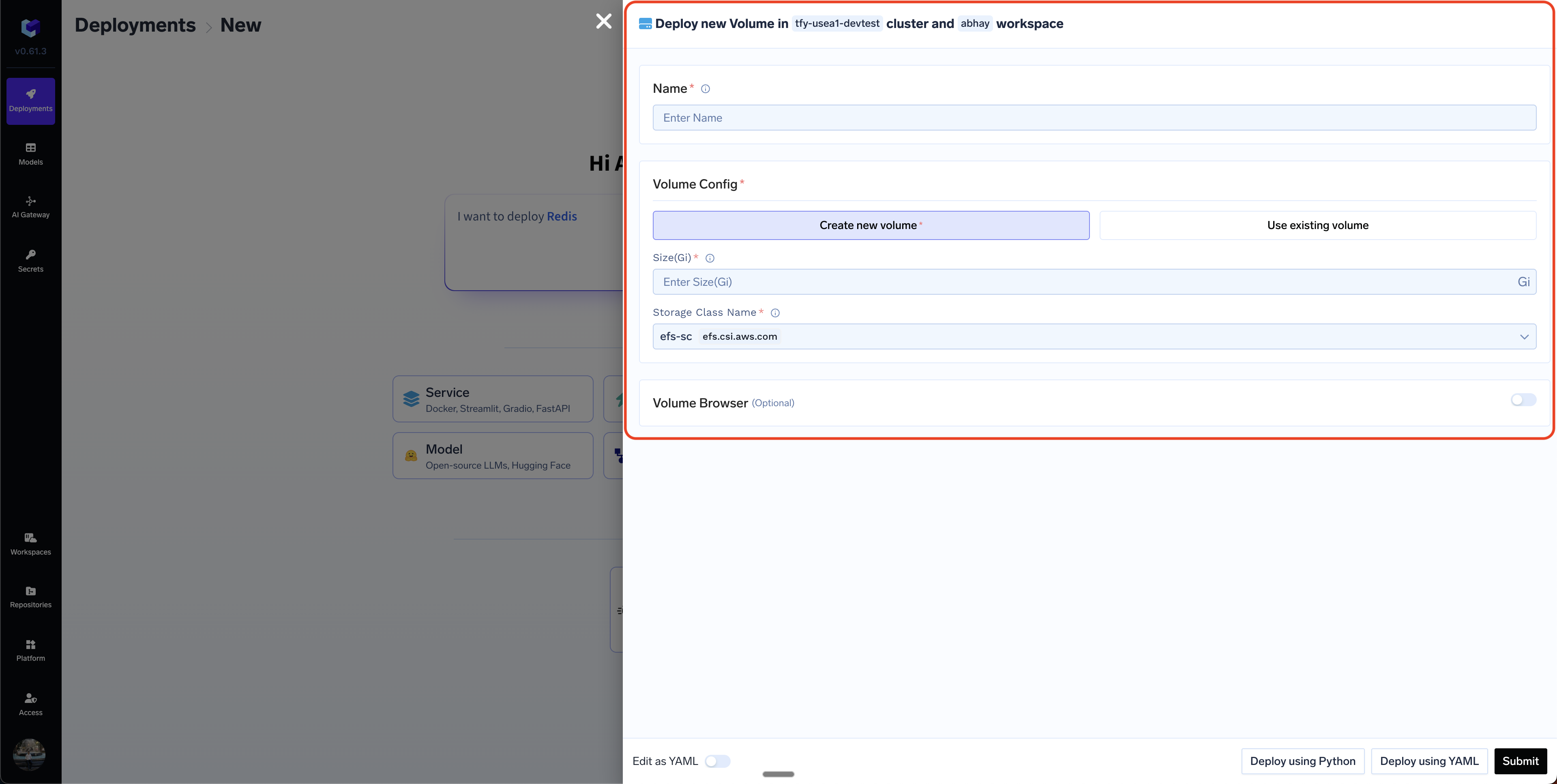New Deployment and select Volume.

To create a volume, you will need to select a workspace.
Volumes created within a specific workspace in TrueFoundry can only be used by applications deployed within the same workspace.This ensures that the volume’s data is accessible only to the applications that are part of the same environment, enhancing security and organization.

- Name: The name of the volume.
- Volume Config: You can select either of
Create New VolumeorUse Existing Volume.
- Create New Volume
- Use Existing Volume
You will need to fill up two fields here:The most common storage classes available in different cloud providers are:
- Size: The size of the volume in Gi.
- Storage Class: The Kubernetes storage class to use for the volume. Storage classes provide a way to specify the type of storage that should be provisioned for a Volume. These storage classes differ in their characteristics, such as performance, durability, and cost. The specific storage classes available will depend on the cloud provider you are using and what is preconfigured by the Infra team.
In case you want to whitelist only certain storage classes in the cluster to be used for provisioning volumes, you can add the
truefoundry.com/enabled: 'true' label to the StorageClass resources. The dropdown will then show only the storage classes with this label.AWS Storage Classes
AWS Storage Classes
| Storage Class | Cloud Provider Storage Name | Storage Class | Description |
|---|---|---|---|
| efs-sc | Elastic File System (EFS) | efs.csi.aws.com | A fully managed, scalable, and highly durable elastic file system that offers high availability, automatic scaling, and cost-effective general file sharing. It’s suitable for workloads with varying capacity needs. |
GCP Storage Classes
GCP Storage Classes
| TrueFoundry Storage Name | Cloud Provider Storage Name | Storage Class | Description |
|---|---|---|---|
| standard-rwx | Google Basic HDD Filestore | filestore.csi.storage.gke.io | A cost-effective and scalable file storage solution ideal for general-purpose file storage and cost-sensitive workloads. It offers lower cost but also lower performance due to its HDD-based nature. |
| premium-rwx | Google Premium Filestore | filestore.csi.storage.gke.io | Provides higher performance and throughput compared to Basic HDD, making it suitable for I/O-intensive file operations and demanding workloads. It’s SSD-based, offering higher performance at a higher cost. |
| enterprise-rwx | Google Enterprise Filestore | filestore.csi.storage.gke.io | Delivers the highest performance, throughput, advanced features, multi-zone support, and high availability, making it ideal for mission-critical workloads and applications with strict availability requirements. It comes with the highest cost. |
Azure Storage Classes
Azure Storage Classes
| TrueFoundry Storage Name | Cloud Provider Storage Name | Storage Class | Description |
|---|---|---|---|
| azurefile | Azure File Storage (Standard) | file.csi.azure.com | Uses Azure Standard storage to create file shares for general file sharing across VMs or containers, including Windows apps. It offers cost-effective performance. |
| azurefile-premium | Azure File Storage (Premium) | file.csi.azure.com | Uses Azure Premium storage for higher performance, making it suitable for I/O-intensive file operations. |
| azurefile-csi | Azure File Storage (StandardCSI) | file.csi.azure.com | Leverages Azure Standard storage with CSI for dynamic provisioning, potentially offering better performance and CSI features. |
| azurefile-csi-premium | Azure File Storage (PremiumCSI) | file.csi.azure.com | Combines Azure Premium storage with CSI for dynamic provisioning and high-performance file operations. |
| azureblob-nfs-premium | Azure Blob Storage (NFS Premium) | blob.csi.azure.com | Uses Azure Premium storage with NFS v3 protocol for accessing large amounts of unstructured data and object storage, catering to demanding workloads with NFS access. |
| azureblob-fuse-premium | Azure Blob Storage (Fuse Premium) | blob.csi.azure.com | Uses Azure Premium storage with BlobFuse for accessing large amounts of unstructured data and object storage, suitable for workloads that require BlobFuse access. |
- Volume Browser: Enabling the volume browser will provide you a user-friendly interface that allows you to effortlessly upload, download, and view files stored within the Volumes. The interface will need to be configured with a password so that only authorized users can view the data in the volume. The password will need to be first created as a Secret and then entered in the form below.
Create the secret for the volume browser password
Create the secret for the volume browser password
Using the Volume
Once you press the submit button in the deployment form, the volume will be created within a few seconds. The Volume Dashboard will transform to appear as follows:
Browse / Upload / Download data using Volume Browser
Browse / Upload / Download data using Volume Browser
Once set-up, you can use Volume Browser to effortlessly upload, download, and view files stored within the Volumes.
Use the volume to store / read data from your deployments
Use the volume to store / read data from your deployments
You can attach Volumes to various types of deployments, including Services and Jobs. You can then read and write data to the volume like you would normally read and write data to a file system.You can read this guide to learn more about how to use volumes in deployments. This guide is for Service, but the same can be applied to Jobs as well.